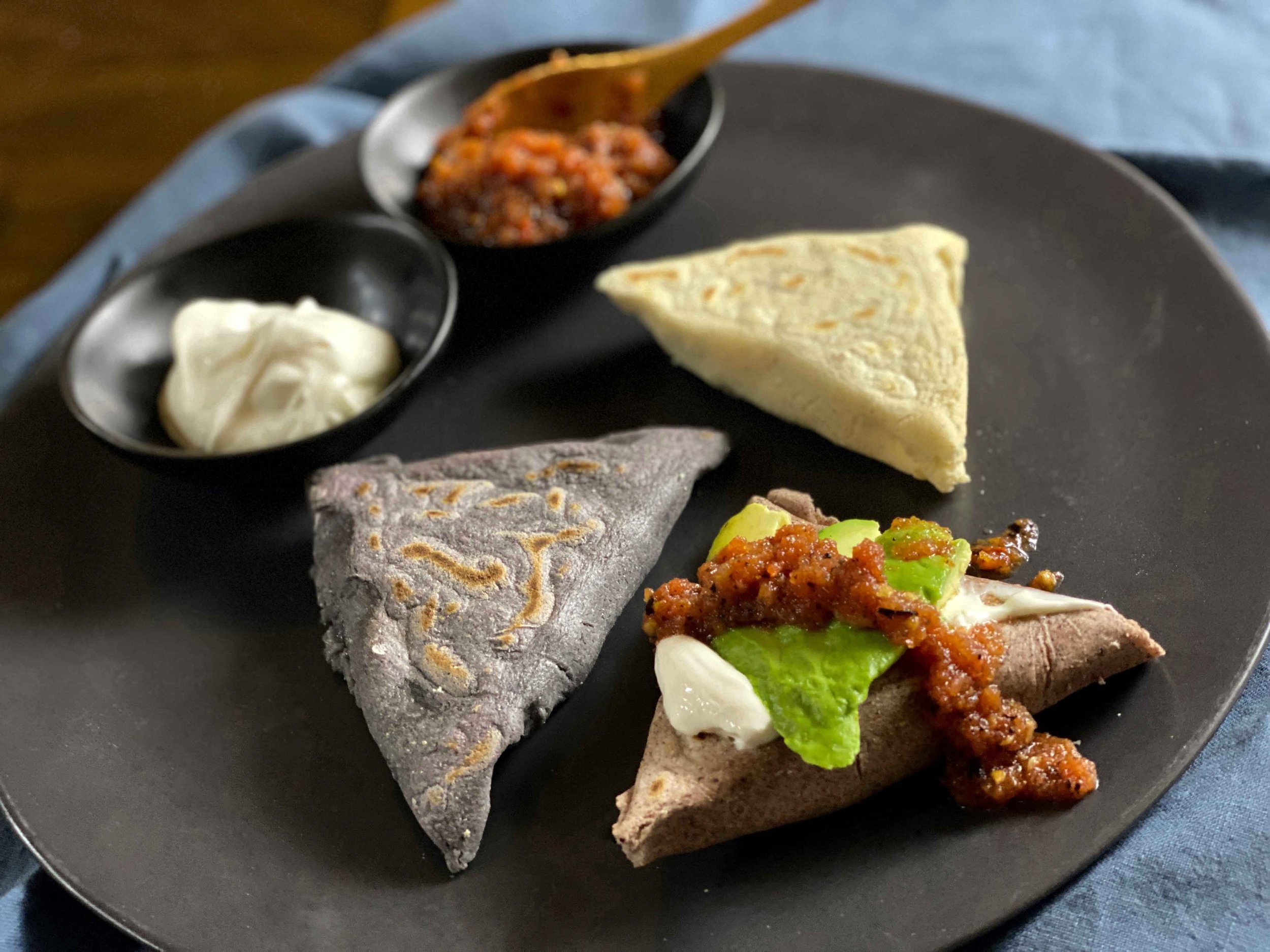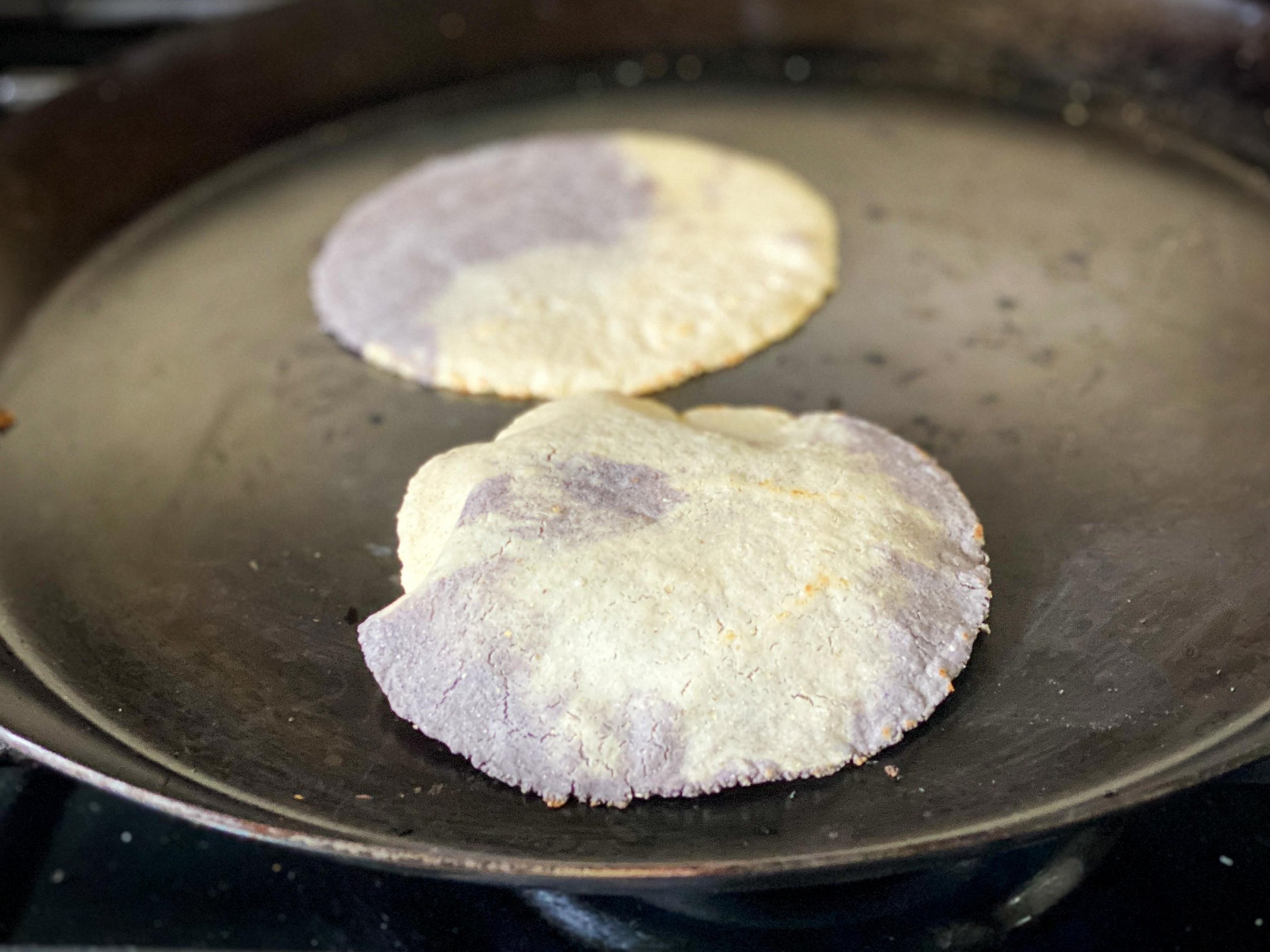By Leslie Brenner
Masa: Techniques, Recipes, and Reflections on a Timeless Staple, by Jorge Gaviria; photographs by Graydon Herriott, Chronicle Books, $35.
For those of us who are passionate about Mexican cooking — whether we are practicing it ourselves or enjoying the creations of chefs and other cooks — the ground has shifted in a very exciting way in the last couple of years. The appearance of heirloom corn, in the form of dried heirloom maíz (field corn kernels) for chefs, and heirloom masa harina (just-add-water masa dough flour) for home cooks, has changed everything.
The seismic shift was fomented and forged in large part by a behind-the-scenes hero: Jorge Gaviria. Now the Miami-born chef and entrepreneur has written a book about it all — Masa: Techniques, Recipes, and Reflections on a Timeless Staple. Though the book is primarily directed at chefs, there’s also plenty in it that will captivate home cooks who are serious about Mexican cooking.
WATCH: “Masa and Heirloom Corn Culture with Olivia Lopez and Jorge Gaviria”
Masa is an important, encyclopedic work that provides a fascinating, complete history of masa, from its Mesoamerican roots all the way up to the present — what Gaviria refers to as the “third wave masa movement.” It’s a great foundation for understanding the basis and evolution of Mexican cooking.
Gaviria’s obsession with masa began in 2013, when he became entranced with the heirloom seed movement during an apprenticeship at Blue Hill at Stone Barns, Dan Barber’s famed upstate New York restaurant. That led him to focus on heirloom corn and travel to Oaxaca. Building on Sin Maíz No Hay País (Without Corn There Is No Country, a grass-roots corn culture movement that had been established in Mexico six years earlier), Gaviria went on to create Masienda— a Los Angeles-based company devoted to heirloom maíz from Mexico. Masienda imports the dried heirloom kernels from small farms in Mexico and sells them to the chefs around the U.S. who nixtamalize it (simmering it with culinary lime) then grind them to make masa.
The resulting heirloom-corn masa is far more flavorful and aromatic — and much better for Indigenous farming communities and the earth — than masa made from the genetically modified commodity corn that during the previous century was the only game around. Fans of groundbreaking Mexican restaurants such as Enrique Olvera’s Cosme in New York and Carlos Salgado’s Taco María in Southern California (among others) have been treated to dishes fashioned from heirloom masa in the years since.
Tetelas made from blue, yellow and red heirloom masa harina
In 2019, Gaviria created and began marketing a game-changing piece of equipment: the Molinito. A miniature version of the mammoth industrial molinos (mills) used to grind masa in restaurants (and the freestanding masa shop/tortillerías all around Mexico), the Molinito suddenly made grinding masa much more accessible to independent start-up chefs and food entrepreneurs stateside without deep pockets or huge kitchens. That helped spark a nationwide heirloom masa movement of pop-ups and small kitchens that includes Brooklyn’s For All Things Good, the California Bay Area’s Bolito, Nashville’s Alebrije, Las Vegas’ Masazul, Houston’s Tatemó and Austin’s Nixta Taquería — whose chef Edgar Rico earned the James Beard Award this year for Emerging Chef. And of course Dallas’ Molino Olōyō, whose chef and co-owner Olivia Lopez is Cooks Without Borders’ Mexican Cuisine Expert.
For home cooks, Gaviria and Masienda also introduced an exciting innovation: masa harina made from the new/old heirloom-corn masa. In the past, the only widely available masa harina was made from that awful GMO commodity corn, whether the Maseca brand (developed and first marketed in 1949 in Nuevo Leon, Mexico) or other brands that came later.
Red, white and blue heirloom-corn masa harina from Masienda
How the book works
The first third of Masa consists mostly of a lengthy section, primarily directed to chefs, explaining how to make nixtamal, how to operate and maintain a molino or Molinito and how to grind masa.
Next comes “Contextualizing Masa.” Here we learn how to press and cook a tortilla, the starting point for many of the shapes that follow. Gaviria explains how to get “puff” — the sought-after effect when a perfectly made tortilla fills with air after being flipped on the comal (griddle). “The puff is to tortilla making what the crumb is to bread baking,” writes Gaviria.
A tortilla made using blue and yellow heirloom masa harina puffs on the comal.
A compendium of masa shapes
The heart of the book is a valuable guide to making 28 masa “shapes” — alphabetized from arepas to chochoyotes, memelas, quesadillas, tamales, tetelas and tlayudos. The shapes originate not only from Mexico; they also come from Central America, South America and even the United States (puffy taco!). For all of them, you can use masa made from masa harina (as well as fresh masa made from nixtamal).
Home cooks will need to be self-directed, figuring out fillings and toppings on their own; recipes for those aren’t included in the book. The 3-page entry on Tlacoyo, for instance, describes “A football-shaped or oval masa pocked, commonly filled with puréed beans, favas, or other pulses and topped with cheese, crema, salsa, and/or onions with cilantro . . . “ (You can find complete recipes, along with salsas and fillings, in Cooks Without Borders Mexican Cuisine Guide, and in other cookbooks.)
What we are given are tlacoyo’s roots (Mexico — Estado de México, Hidalgo, Pueblo); the format (“stuffer and topper”) and cooking method (“comal or fried”). Next comes practical information about mixing fat into the masa if you intend to freeze the tlacoyos, and then written instructions on shaping, filling and cooking the tlacoyo. Step-by-step photos (by Graydon Herriott) are excellent visual aids.
Ten chef recipes
The final short section, “Modern Masa Explorations,” is where you find the book’s only conventionally formatted (headnote, ingredient list, detailed instructions) recipes — 10 cross-cultural recipes from chefs. Among them are Blue Masa Sourdough Bread from Philippine-born Karlo Evaristo; Lamb Birria with Masa Gnocchi from Gerardo Gonzalez (Lalo, New York City); Shrimp and Masa Grits from Sean Brock (McCrady’s, Charleston, SC); and Masa Samosas from Saw Naing (Tallula’s, Santa Monica, CA).
The one I tested — White Chocolate Chip Cookies — came from Jess Stephens, who worked in the pastry program at Empellón in New York City.
Buttery and irresistible, with a bit of masa harina incorporated into the dough, they begin with white chocolate chips that are caramelized and melted in the oven, then hardened and broken into chunks — resulting in a flavor is so much more interesting than plain white chocolate.
Gaviria tells me he has begun work on developing a second book, one geared more directly for home cooks — which is great news.
Until then, his outstanding debut effort — which I highly recommend — gives us plenty to chew on.
Find more cookbook reviews from Cooks Without Borders
If you enjoyed this story, you might like:
“Salsa macha is the hottest condiment of the year, and we’ve got the best recipe”
“The masa life: Making out-of-this-world tamales is totally within your power!”
“How to make tetelas: Those tasty, triangular masa packets that are about to become super trendy”
“Cookbooks We Love: ‘Budmo!’ deliciously captures the spirit of Ukraine”
“Cookbooks We Love: The flavors of India’s cultural capital shine in ‘Kolkata’”
“Cookbooks We Love: Hooni Kim’s ‘My Korea’ is a knockout of a Korean cooking primer”
Sign up for free Cooks Without Borders recipes delivered to your in-box!





